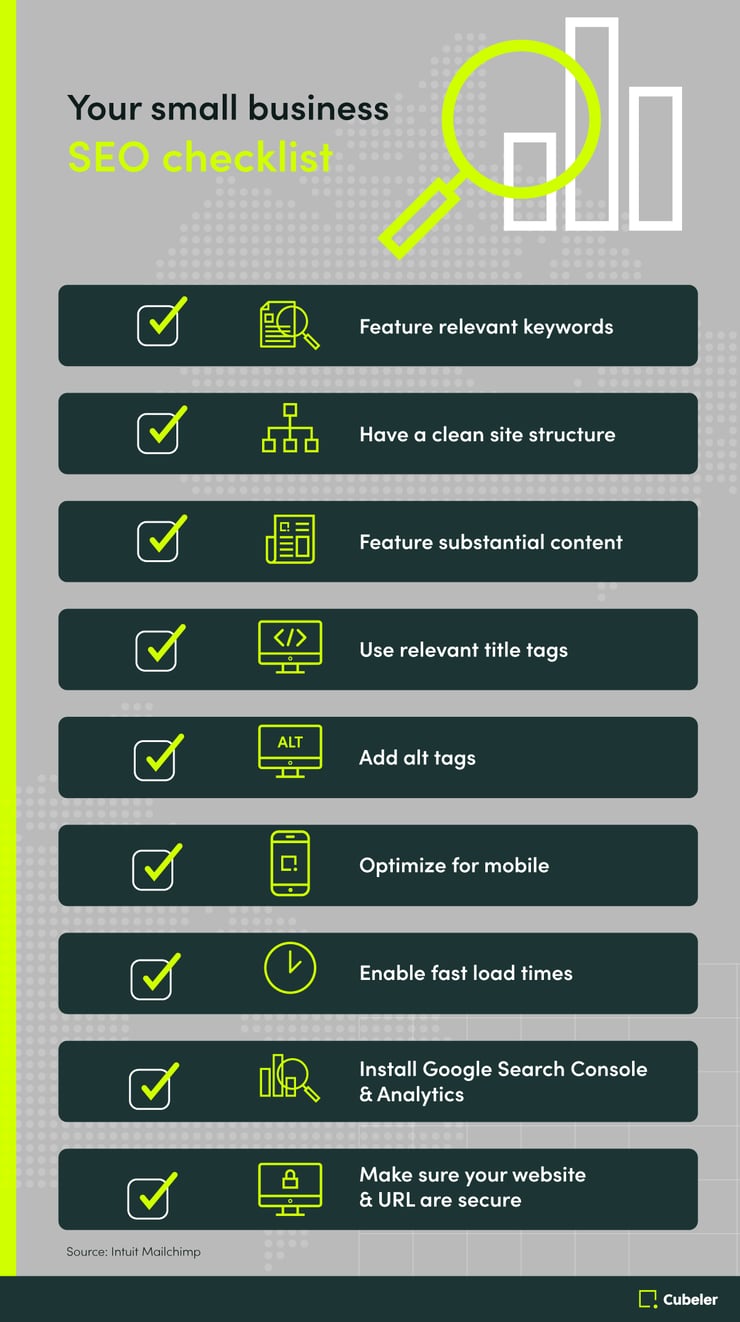Top 10 Digital Transformation Fails—and How to Sidestep Them
Discover how to sidestep the top 10 digital transformation fails with a step-by-step plan to integrate the right...
12 min read
By:
Cubeler en-ca
26-Feb-2024 5:44:21 PM

Find out what you need to know to bypass the most common marketing pitfalls.
Running a small business is not for the fainthearted. It demands courage, endurance and unwavering determination. It is for individuals who can rise above challenges—lots and lots and lots of challenges.
For many small business owners, the path to success is laden with challenges, big and small, particularly when it comes to marketing.
Navigating the marketing arena requires more than just a good product or service—it requires strategic thinking and a keen understanding of the common pitfalls that can derail even the savviest of small business marketers.
From failing to understand your target market to underestimating the power of an online presence, these pitfalls can hinder the growth of your business and limit your reach to potential customers. Recognizing these traps is the first step towards overcoming them.
Here, we will empower you with the knowledge and tools you need to bypass the most common pitfalls effectively—to not only survive but thrive in Canada's competitive landscape.
Understanding the heartbeat of your audience is not just an advantage—it is a necessity. This is where market research comes into play.
Market research is the foundation of crafting any marketing strategy that resonates well with your target demographic. It is about moving beyond a superficial understanding of your market to pinpoint the unique needs, preferences and behaviour that drive your customers.
Conducting market research ensures every dollar you invest in marketing propels your business forward, not just out into the void.
Ignoring market research costs you more than just money
What are the risks of bypassing market research? Basically, you risk allocating your budget to channels that don't connect, creating messages that miss the mark and, ultimately, letting golden opportunities slip through your fingers.
Eventually, the consequence of ignoring market research is not just financial. It is also a matter of relevance. In a marketplace as diverse as Canada's, a one-size-fits-all strategy is a recipe for invisibility.

Conducting market research the small business way
If the idea of conducting research seems daunting, start with the basics:
Each of these techniques provides a distinct perspective for understanding your business from the eyes of your customers.
With these methods, you will not only avoid the pitfall of ignoring market research, but you will also set your business on a path of sustained growth. Remember, in the vast Canadian market, knowledge is not just power—it can be profitability.
As a business owner, gathering customer feedback is crucial for understanding your customers and market. Acting upon what your existing and prospective customers tell you is even more critical for your business.
Embracing customer feedback with open arms allows you to refine your products, services and marketing strategies in a way that resonates deeply with your audience.
Making Changes That Matter
Acting on the feedback you collect is where the real marketing magic happens. It is not just about listening—it is also about making meaningful changes that reflect customer desires and concerns.
Here are three examples of changes you may need to make:
The Importance of Active Engagement
By actively engaging with, and responding to, feedback on these platforms, you demonstrate your commitment to customer satisfaction and continuous improvement.
Ultimately, overlooking customer feedback is a missed opportunity for any Canadian small business.
By actively seeking out, listening to and acting upon customer feedback, you can steer your business towards success, ensuring that your services and products not only meet but exceed the unique expectations of your customers.
For Canadian small business owners, branding should not just be considered a tool but also a cornerstone of their market identity.
Branding, far beyond a mere logo or a catchy tagline, embodies the essence of your promise to customers. It is the silent language that communicates the values, story and commitment of your business, setting the stage for building profound customer loyalty and distinguishing your company from the competition.
Developing a powerful brand identity
Crafting a compelling brand identity involves consistent messaging across all platforms, from your website to social media and, for retailers, the in-store experience.
Brand consistency breeds familiarity, and familiarity builds trust—a crucial ingredient in the Canadian market, where consumers value authenticity and integrity.

Fostering deeper connections with consumers
Incorporating local symbols and motifs into your branding can also foster a deeper connection with consumers. This approach, however, requires a delicate balance. It means celebrating cultural icons without veering into cliché territory, ensuring that every element of your branding genuinely respects and reflects the values of the local market.
By embedding these values into your brand and maintaining consistency in your messaging, you not only can carve out a unique space in the marketplace but also invite your audience into a shared narrative that celebrates their identity and values.
Such a strategy not only sets your business apart but also builds a loyal customer base that sees your brand as an extension of their community and ideals.
In today's fast-paced world, the internet is the town square for global commerce, making an online presence not just beneficial but essential for small businesses.
Of course, it is not enough to simply exist online. Your digital footprint must be strategic, engaging and tailored to your audience. For Canadian small businesses, this means creating a presence that's not just visible but also vibrant and inclusive.
The Foundation of Your Online Presence: Website and Social Media
Your website is often the first point of contact between your business and potential customers. It should be more than a digital business card. Your site should be a home that welcomes visitors with open arms, offering them valuable content, easy navigation and a seamless user experience.
Equally important is your social media presence, which allows you to engage directly with your audience, providing a platform for conversation, community building and customer service.
SEO: The Beacon That Guides Customers to Your Door
Since your website plays a huge role in welcoming existing and prospective customer, search engine optimization (SEO) is crucial.
By incorporating relevant keywords, producing quality content and ensuring your site is mobile-friendly, you can improve your online visibility on search engines.

For Canadian businesses, this means considering local nuances, such as regional search trends, to effectively reach your target audience.
The Importance of Being Local with Your Content
In Canada, embracing our diversity can set your business apart. Localized content that reflects regional preferences and cultural nuances can significantly enhance customer engagement and loyalty.
What is content localization? It goes beyond mere translation, aiming to tailor content to resonate well with audiences in different markets. This process acknowledges and incorporates cultural, linguistic and market-specific nuances to ensure the content feels local and relevant.
Here are key aspects of content localization:
Accessibility: A Must-Have, Not an Afterthought
Canada's commitment to inclusivity extends online. Ensuring your website meets accessibility standards is not just a legal requirement. It is a moral imperative, ensuring everyone, regardless of ability, has access to your content.

Sources: Ontario Ministry for Seniors and Accessibility, Statistics Canada and Accenture
A robust online presence is non-negotiable for small businesses aiming to thrive in the Canadian market. By embracing SEO, localizing content and prioritizing accessibility, you are not just marking your digital territory—you are inviting the world in, one click at a time.
In today’s diverse and competitive marketplace, standing out is not just an advantage—it is a necessity. For small business owners, identifying and effectively communicating your unique selling proposition is the cornerstone of differentiation.
What makes your business distinctive
But what makes your business truly unique? Is it a product, a service or perhaps an unforgettable customer experience? Pinpointing this uniqueness is not only about what you sell. It also means encapsulating the essence of why your business matters in the hearts of your customers.
Competitor analysis plays a crucial role here. By understanding where your competitors excel and fall short, you can navigate through your industry's crowded waters and identify unmet needs or service gaps. This is where your business can shine by offering something they don't.
Whether you are leveraging local knowledge, specialized expertise or even a unique approach to customer service, these elements can significantly set you apart in your market.
Incorporating local flavours and nuances
Incorporating local flavours and nuances into your unique selling proposition can further cement your place within the community.
For instance, if you are located in a region known for specific products or cultural heritage, highlighting these aspects can attract those seeking authentic experiences.
Another avenue for differentiation
Networking with other local businesses offers another avenue for differentiation.
Through cross-promotion or collaborative initiatives, you can create a unique ecosystem around your business that not only elevates your brand but also strengthens the local business community.

In today's digital landscape, content marketing has emerged as an indispensable tool for businesses aiming to attract, engage and retain customers.
Content marketing involves creating and distributing valuable, relevant and consistent content to attract a clearly defined audience—with the goal of driving profitable customer action.
From blogs and videos to infographics and podcasts, content marketing offers a plethora of formats to connect with your audience on a deeper level.
Content marketing nurtures loyal customers
For small business owners, opting for content marketing not only helps in establishing authority and trust but also in nurturing a loyal customer base.
It is essential to craft content that resonates with your audience’s needs and interests, fostering a connection that transcends the transactional nature of traditional marketing.
Tailoring your content marketing strategies to address topics relevant to your target audiences can significantly enhance your engagement rates. Whether you incorporate case studies, share success stories that inspire and connect or leverage national holidays and cultural moments, each piece of content should feel close to home for your audience.
Creating content that reflects the diversity and vibrancy of your market
Creating content that speaks to your market requires a nuanced understanding of local interests, preferences and issues. It is not only about translating global trends into a local context—it is also about highlighting local stories and experiences that reflect the diversity and vibrancy of your local market.

Remember, content marketing is not a one-size-fits-all solution. It demands creativity, consistency and a keen understanding of your audience.
By providing value through your content, you are not just marketing your business— you are building a community around your brand. This is especially true in the Canadian market, where consumers appreciate authenticity and local flair.
So, as you plan your content marketing strategy, consider what makes your target audience tick—and how you can deliver content that not only informs and entertains but also inspires and engages.
Marketing budget mismanagement is a common pitfall that can significantly impact the growth and sustainability of any small business.
The key to effective marketing is not necessarily spending more—but spending wisely. This means allocating your budget to channels and strategies that offer the best return on investment (ROI) and align with your business goals.
Allocating your budget to the right marketing efforts
Here are eight ways to allocate your budget to marketing initiatives with the best return on investment (ROI):
By avoiding common budgeting mistakes and strategically allocating your marketing funds, you can achieve more with less, ensuring every dollar you spend contributes to the sustainable growth and success of your business.
With the ever-evolving needs of today’s consumers, staying abreast of new marketing trends is not just profitable—it is vital for survival.
For small business owners, adapting to these changes is particularly crucial due to the unique dynamics of the marketplace. Understanding and leveraging the latest marketing innovations can mean the difference between thriving and merely surviving.
The latest trends reshaping the way businesses connect with audiences
Recent trends such as influencer marketing, augmented reality and voice search optimization are reshaping the way businesses connect with their audience.
But how can you keep pace with these trends?
Adapting your marketing strategy to incorporate the latest trends doesn't mean overhauling your entire approach. Start small by integrating one or two innovations that align with your business goals and resonate with your target audience. Then, monitor the results closely, using them to guide further investments in these areas.
By staying informed and flexible, small business owners can leverage new marketing trends to stay competitive and connect with consumers in more meaningful ways.
Small business owners face the challenge of making their brand stand out, especially when the default strategy seems to lean heavily towards paid advertising.
While paid ads can offer a quick visibility boost, they are not a silver bullet for sustained business growth.
Integrating paid, owned and earned media
The key lies in developing a diversified marketing strategy that integrates paid, owned and earned media, ensuring a more holistic approach to reaching your audience.

Paid advertising, when used as the sole marketing tactic, runs the risk of draining resources with potentially low return on investment, especially in the crowded Canadian ad space.
Moreover, consumers are increasingly seeking authentic connections with brands, something that paid ads alone cannot provide. This is where the blend of content marketing, social media engagement, SEO and even offline efforts come into play, creating multiple touchpoints with your audience.
Building a sense of community
To truly resonate with consumers in your market, consider sponsoring local events or partnering with local charities. This not only increases your brand visibility but also builds a sense of community and shows your commitment to local values.
Additionally, collaborations with other Canadian businesses through co-marketing efforts can amplify your reach, offering mutual benefits without the hefty price tag of solo paid advertising campaigns.
Remember that your marketing strategy should be as diverse as your industry. Leverage the strengths of multiple marketing channels to build a robust presence that speaks directly to your audience, fostering loyalty and driving sustainable growth.
By moving beyond a reliance on paid advertising, you create a richer, more engaging brand story that your existing and prospective customers can connect with, setting the foundation for long-term success.
Overlooking the need to measure and analyze your marketing results can hinder you ability to determine if your business is heading in the right direction. For small business owners, this oversight can lead to missed opportunities and the inefficient use of financial and human resources.
The need to measure the effectiveness of your marketing strategy cannot be overstated. It entails more than tracking sales. It also means understanding which and why specific marketing efforts are resonating with your audience. This knowledge is crucial for refining your approach and ensuring your marketing dollars are well spent.
Basic analytics tools and metrics can serve as your guideposts:
Together, these tools are invaluable for gauging the success of your marketing campaigns and understanding your audience's preferences.

Embracing a culture of measurement and analysis has its benefits
Adjusting strategies based on performance data is not just recommended—it is essential for growth. If a particular type of content or marketing channel is performing well, consider allocating more resources to it. Conversely, if something is not working, it is time to pivot or improve.
By embracing a culture of measurement and analysis, small business owners can navigate the complexities of the market more effectively, ensuring that their marketing efforts are not merely a shot in the dark but a strategic move towards growth and engagement.
Remember, every piece of data tells a part of your business story. Make sure you are listening.
Quick Takeaways
Here are 10 key takeaways to help small businesses avoid the most common marketing pitfalls effectively:

Discover how to sidestep the top 10 digital transformation fails with a step-by-step plan to integrate the right...

Get a summer SME toolkit to transform your talent challenges into opportunities for growth in a tight labour market.

Find out what you need to know to bypass the most common marketing pitfalls.